Martin B-26 Marauder, 41-34718, Termonfeckin, Louth
The town of Termonfeckin, County Louth had an unexpected visitor on the afternoon of 4th June 1943 with the appearance of a bomber aircraft over head. It shortly after made an emergency belly landing on the beach outside of the town.
Termonfeckin lies on the east coast of Ireland, b13:30etween
Dublin and Northern Ireland. The location of the landing is
recorded as being 'Beltrae Strand' by the Irish Army at the
time. The area of Seapoint, directly across from
Termonfeckin on the coast is associated with this crash
nowadays. The townland of Beltray is shown on maps too be south
of Termonfeckin and there is a town of the same name. The area
is now, as it was during the war, a holiday resort with golf
courses on the shore. There is not much detail as too the exact
location of the crash in the Irish Army report.
The Irish authorities were at the scene quickly after the landing in the form of Local Defense Force (LDF) and the Irish military. They found that there were four crew men on the aircraft and no injuries had been suffered among them. The crew reported that they were flying a the aircraft on a ferry mission from the United States via Port Lyautey in Africa and were on the final leg of the journey to Pembroke in England. They said they had experienced high head winds and these blew them off course. Having become lost and low on fuel they elected to make a forced landing. The Army report recorded that the aircraft was a B-26C model with serial number '34718'. The report makes little comment on the dealings with the crew after the crash but it would be normal that after a short rest in the area they were probably brought to the border with Northern Ireland that same day.
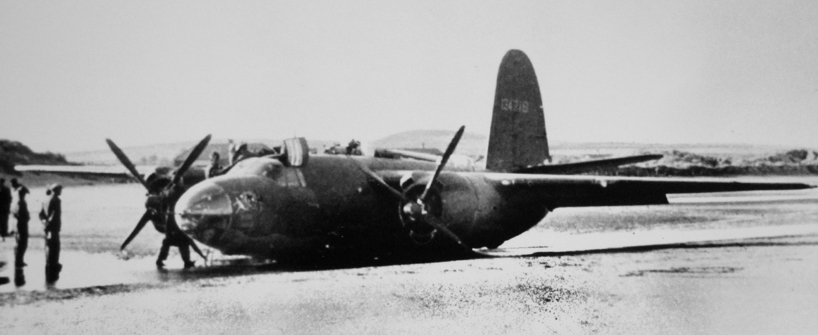
The crew names were recorded as 1st Lt G A Seeley, 1st Lt W J
Wilson, S.Sgt F E Sandora and S/Sgt W Prichard with crew
positions as Pilot, Bombardier, Radio Officer and Engineer
respectively. Post war research and access to the US Army Air
Forces records show that the aircraft was a B-26 Marauder medium
bomber of the US Army Air Forces. The crash report for this
incident is fairly extensive in that it contains seven pages of
testimony from three members of the crew as well as the
following summary from an Army Air Forces:
B-26C #41-34718 piloted by 1st Lt. G.
A. Seeley with a crew consisting of a bombardier-navigator,
engineer, and radio operator, while enroute from Port
Lyautey, French Morocco to St. Eval, U.K. on June 4 1943
became lost form his formation while flying on instruments
in an overcast and made a deferred forced landing at 1600
hrs, 4 June 1943, in Eire. No injuries to personnel
were sustained. Only damage to A/C was underside of
fuselage due to wheels up landing and two blades bent on
each prop, however location of plane on beach is such that
tide rapidly causing deterioration.
The pilot's becoming lost is
attributed to a combination of factors. First of all,
his artificial horizon went out soon after take of and his
gyro compass not long after. This lack of flight
instruments hindered his accuracy of instrument
flying. Secondly, the pilot became lost from his
element leader while flying in the overcast. The
element leaders plane carried a competent celestial
navigator. Thirdly, atmospheric conditions prevented
successful use of radio aids. Fourthly, an uncharted
tailwind caused the A/C to reach the Southern Eire coast 15
minutes before ETA at 50 Deg N. latitude for turn on to
easterly course for St. Eval. This resulted in
confusion on part of crew. At first the pilot and
navigator thought they might be over France. The pilot
eliminated this possibility after flying est for a while,
then North until a coast line was again reached with water
on his right.
No aerodromes were marked on the
navigator's map of Eire and N.I.
The pilot had not managed to orientate
himself with respect to Ireland or England until his fuel
had become low and he was on his approach leg for a forced
landing on the beach.
Just before the pilot landed he saw a
sign or rather the letters spelling EIRE but he did not have
sufficient fuel left to try to orientate his location in
Eire. he had not spotted any aerodromes or suitable
landing fields while flying over Eire.
Pilot was briefed to maintain radio
silence until 50 Deg parallel was reached except in an
emergency. Pilot did not consider losing sight of
element leader in overcast as constituting an emergency, and
consequently did not try to contact leader while in the
overcast.
The aircraft, a B-26C-5-MO Marauder, built in the Martin factory at Omaha, Nebraska was a brand new bomber on a delivery flight from the United States to Europe. It was flying on the long southern Atlantic route involving flying south out of Florida to Puerto Rico, Brazil, Ascension Island, Monrovia in Liberia, Morocco and then to Port Lyautey. They had taken off in a formation of eight aircraft from Port Lyautey but after about six hours into the flight, they ran into cloud and this resulted in them loosing site of their formation. They were on radio silence at the time and maintained that silence after loosing the formation. They sighted land but could not identify it and realized they were off course. They determined that they had reached Ireland or England but none of their radio aids could get signal enough to assist them. The navigator on this flight was the bombardier who recorded in unit histories that he had been given a crash course in navigation before departure. It was common for medium bombers and transports to fly these missions without a trained navigator, Air Transport Command would assign one to the lead aircraft in a formation to provide navigation for the whole group of aircraft. Having taken off at 07:25 GMT, at 15:30 GMT Lt Seeley found himself running low on fuel over unfamiliar territory. Having failed to find any suitable landing ground he flew east too the coast and chose a long stretch of beach to put the aircraft down on.
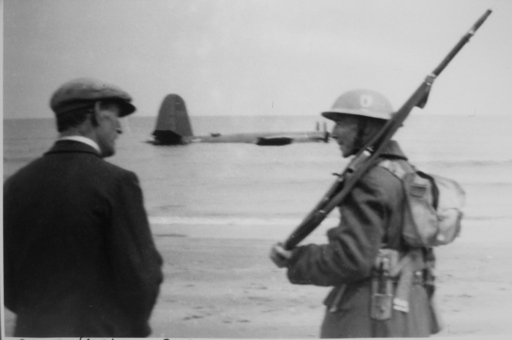 The
aircraft was brought to a firm halt on the beach with no
injuries to the crew. The engines had been cut prior to landing
and the only obvious damage was too the underbelly of the bomber
and bending of the propeller tips on each side. However, as
recounted also in the Irish Army report, the aircraft had been
put down below the high water mark and in the ensuing hours the
salt water engulfed the aircraft rendering it beyond repair. In
the following days, members of the Irish Air Corps, with the
assistance of American military and civilian contractors from
the Lockheed Overseas Airways Corporation, moved the ruined
bomber up from the beach onto more solid ground. There the
landing gear was dropped to place the aircraft on a more solid
footing and the crews set about dismantling the aircraft.
The
aircraft was brought to a firm halt on the beach with no
injuries to the crew. The engines had been cut prior to landing
and the only obvious damage was too the underbelly of the bomber
and bending of the propeller tips on each side. However, as
recounted also in the Irish Army report, the aircraft had been
put down below the high water mark and in the ensuing hours the
salt water engulfed the aircraft rendering it beyond repair. In
the following days, members of the Irish Air Corps, with the
assistance of American military and civilian contractors from
the Lockheed Overseas Airways Corporation, moved the ruined
bomber up from the beach onto more solid ground. There the
landing gear was dropped to place the aircraft on a more solid
footing and the crews set about dismantling the aircraft.
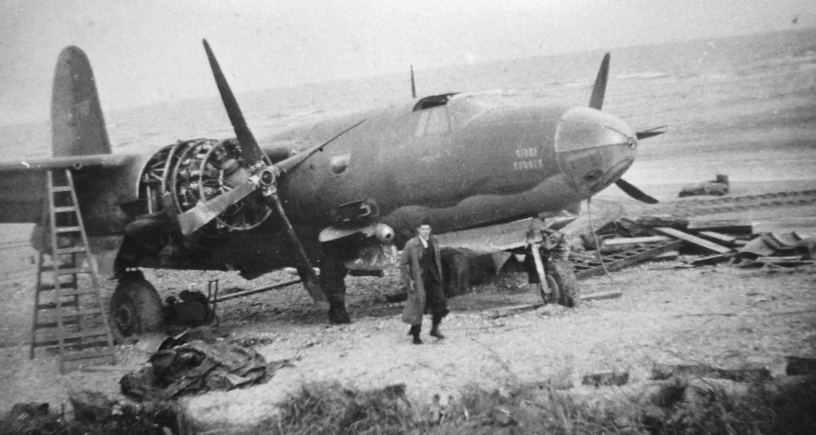
Finally, on June 30th, the dismantled remains of 'Ridge Runner'
were taken by truck to the border and taken to an American base
within Northern Ireland.
Local Louth man Brendan McLeer was kind enough to provide these
family photos of the dismantled aircraft being trucked through
the town of Clougherhead. The vehicles are shown parked on
the main street between the Star of the sea guest house and the
then butchers, now Corrs pharmacy. One can see the
enormous propellers, both of which are damaged, the two engines
and the horizontal tails on the low loader trailer. The
truck facing the camera is a Bedford OX model, and was used to
tow the Queen Mary trailer seen carrying the aircraft
components.
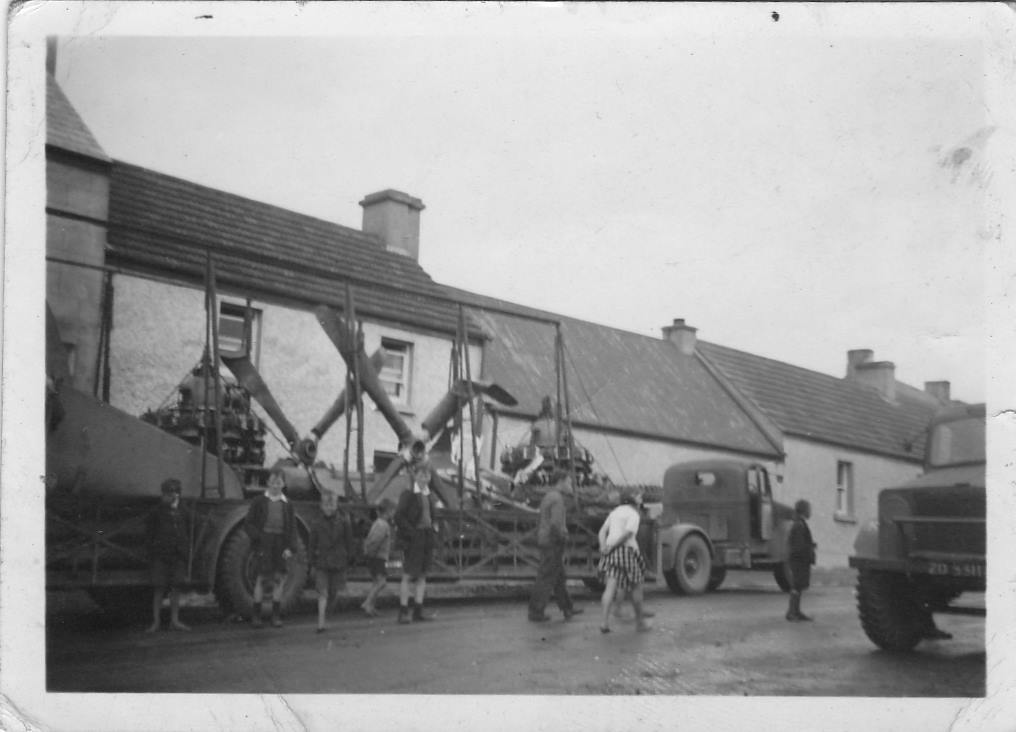
In this photo then the truck across the road is now parked next
to the trailer and the first two digits of the aircraft serial
number can be seen on the tail fin stacked in the
trailer. It was USAAF policy to leave off the first
digit of the year of the aircraft's serial number, hence this
aircraft, 41-34718 carried the serial 134718 on its tail.
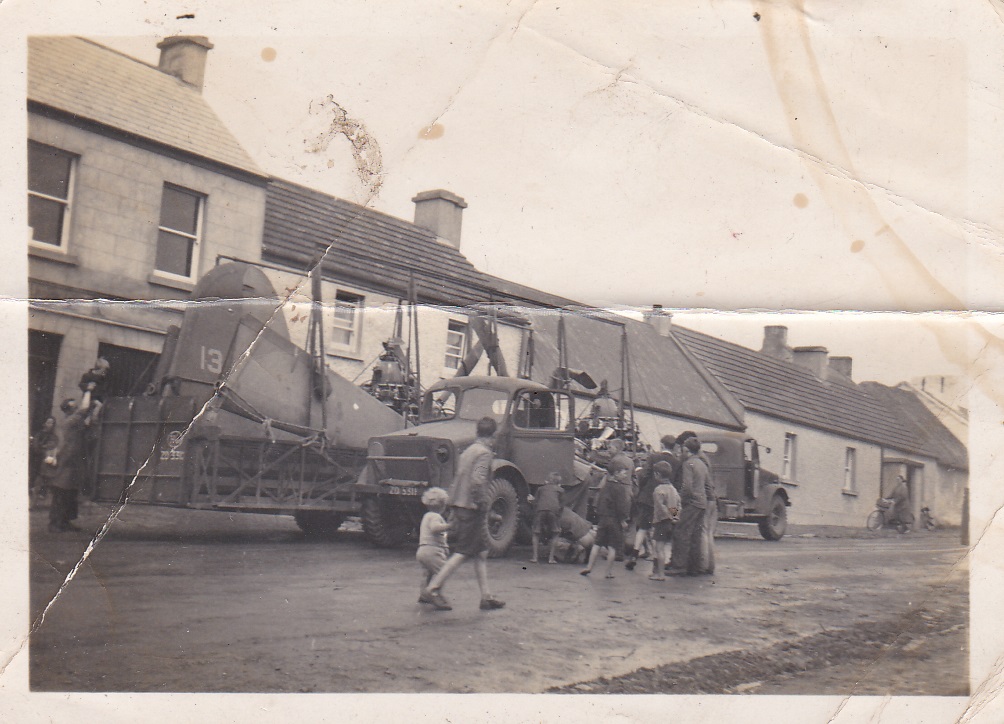
Ridge Runner was the name of the aircraft, painted on the sides of the aircraft nose. It can be seen in the photo above. The left hand side of the aircraft also carried some interesting nose art in the form of a man, A 'Ridge Runner' chasing a scantily clad young maiden! Crew members Seeley and Wilson both recalled many years after that the first people to meet them on the beach after the landing were a group of nuns!
The photos below were supplied by the Seeley family in 2008. The first image shows the crew taken in County Louth with some Irish people. The remaining two photos were crew photos taken probably in England during the men's combat tour.
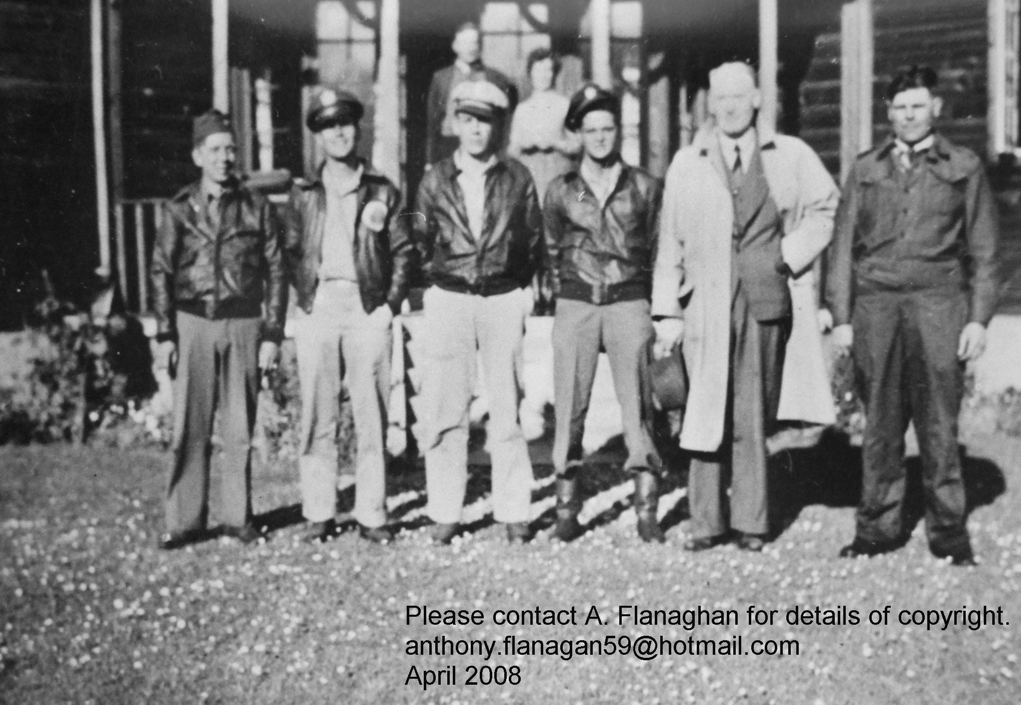
This blurred image above seems to show, standing from left to right, Frank Saunders, Walter Wilson with his trade mark grin, Grant Seeley and Billy Prichard.
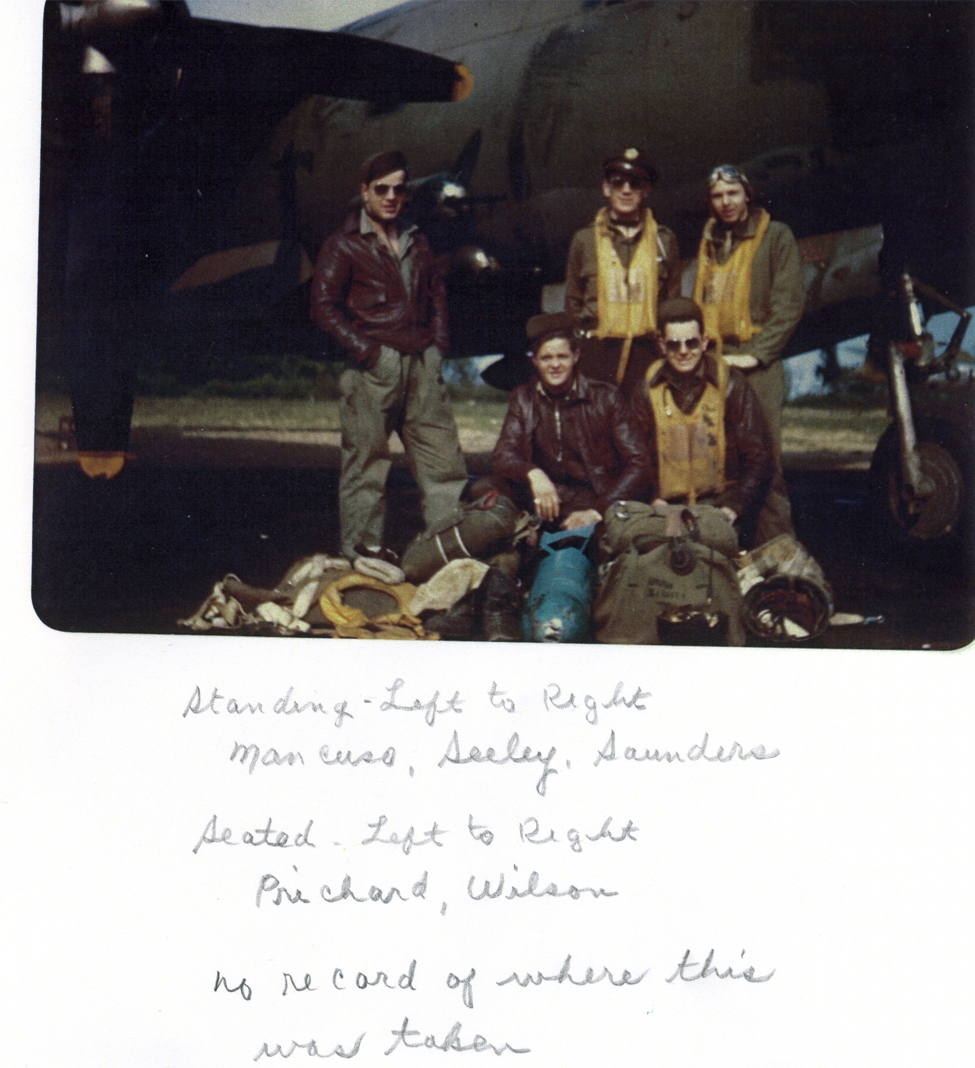
The caption identifies the men as: Standing: Left to right: Mancuso, Seeley, Saunders, Sitting, left to right: Prichard and Wilson.
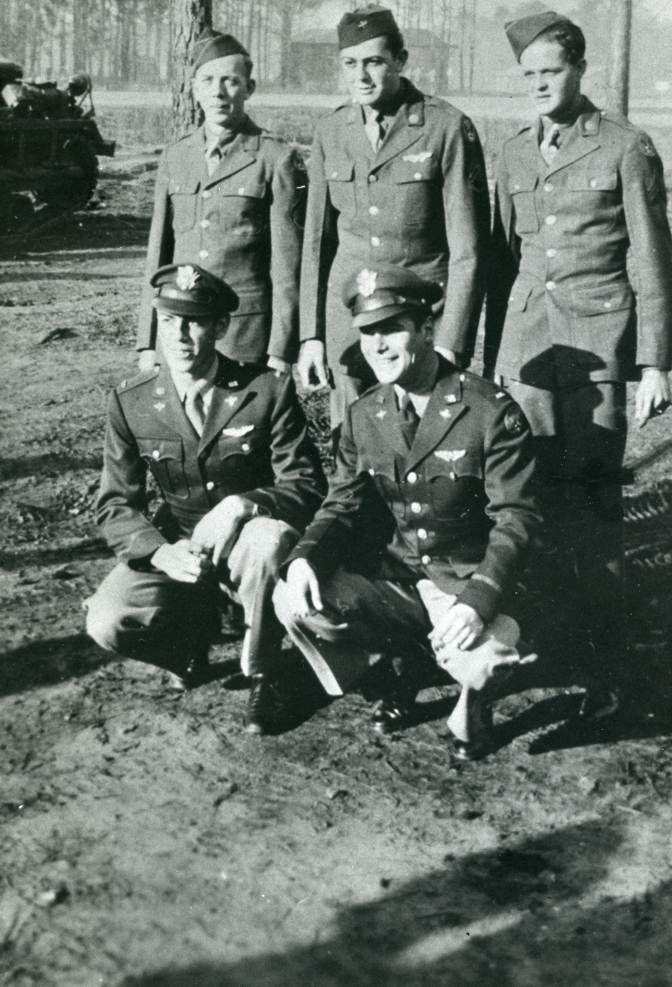
Marked on the back of the image above, the men were identified
as:
Standing: Left to Right: Saunders, Mancuso, Prichard
Front Left: Seeley, Right Wilson
Frank E Mancuso was a new member of the crew, added after arriving in England. He was the top turret gunner. He passed away in 2010. His obituary states: In February he went overseas with the 323rd Bomb Group, 454th Bomb Squadron, and was stationed primarily at Earls Colne, England. He flew 67 missions as a top turret gunner on the B-26 and was credited with shooting down an FW-190 on his 4th mission over Amiens, France. Frank was awarded the Distinguished Flying Cross with one cluster and the Air Medal with 10 clusters.
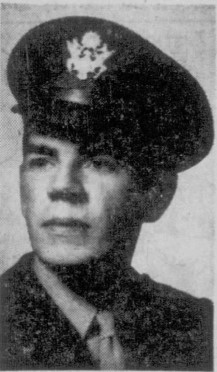 Grant A
Seeley O-727784 completed his tour of duty with the 323nd
Bomb Group. He then transferred to flying fighter aircraft and
served another tour with the 355th Fighter Group. His son
understood that he flew with the same crew of Wilson, Saunders,
Prichard and Mancuso for over 50 missions with the 323rd Bomb
Group.
Grant A
Seeley O-727784 completed his tour of duty with the 323nd
Bomb Group. He then transferred to flying fighter aircraft and
served another tour with the 355th Fighter Group. His son
understood that he flew with the same crew of Wilson, Saunders,
Prichard and Mancuso for over 50 missions with the 323rd Bomb
Group.
He had another scary landing on 3rd January 1944 when he force landed P-51 Mustang, 44-14564, a photo of which can be found on the Imperial War Museum website here and here.
Newspapers in Salt Lake City published articles about him in
October 1943 when word was received if his award of a
Distinguished Flying Cross.
Army Awards S. L. Pilot Flying Cross
First Lieutenant Grant A. Seeley, pilot with Eighth air
force operating out of England, has been awarded the
distinguished flying cross, according to word received by
his parents. Mr. and Mrs. Dean W. Seeley, 977 Ninth East
street. He also holds the oak leaf cluster for missions
completed over enemy territory.
Following a bombing raid over enemy-occupied France,
Lieutenant Seeley and his crew delivered their load of bombs
and returned to their base, although their B-26 Marauder
plane had been damaged on the raid and was operating only on
the power of one motor.
Entering the service in 1941, Lieutenant Seeley was
sent overseas last March after receiving basic training at
Thunderbird Field, Ariz.: McDi11 Field, Fla., and Myrtle
Beach, S. C. He was attending Utah State Agricultural
college at Logan when he entered the service.
Grant was born in July 1920 in Mount Pleasent, Utah, to Dean
and Margaret Seeley. Upon his return from wartime service,
he married in Las Vegas in 1945 while he was still serving with
the USAAF. His death occured on 18 August 1999. His
obituary recorded of his lifes interests:
He coached Little League and Cops
League Baseball for several years. Was a lifelong model
airplane builder, an avid reader, dedicated golfer, and
enthusiastic gardener. In his younger years, he enjoyed
hunting, fishing, and camping.
He was employed by the Salt Lake City Police Department for
thirty-two years, where he served a term as president of the
Police Mutual Air Association and was a qualified marksman.
His obituary in August 1999 reads:
Grant Allen Seeley, Sr., 79, died at
LDS Hospital on August 18, l999 after a lingering illness.
Born July 8, 1920 to Dean Winters Seeley and Margaret
Abegglen Seeley at Mt. Pleasant, Utah. He married Salome
Walch in Las Vegas, Nevada, October 25, 1945. He was
educated in Uinta Basin schools, Wasatch Academy and Utah
State University. He was a veteran of World War II and
served in the Army Air Corps, European Theater. He flew 60
missions in B-26 Marauder Bombers and 37 missions in P-51
Mustang Fighters. His military decorations included the
Distinguished Flying Cross with two oak leaf clusters, Air
Medal with eighteen oak leaf clusters and the Purple
Heart.He was employed by the Salt Lake City Police
Department for 32 years where he served a term as president
of the Police Mutual Air Association and was a qualified
marksman. He coached Little League and Cops League Baseball
for several years. Was a lifelong model airplane builder, an
avid reader, dedicated golfer and enthusiastic gardener. In
his younger years he enjoyed hunting, fishing and camping.
(Deseret News, Utah, Friday 20 Aug 1999)
Walter Wilson O-661057 was born in August 1916 in Glen
Cove, New York to Etta and William Wilson. served
throughout the war with the 323rd Bomb Group and later with A-20
and A-26 units of the 98th Combat Wing. Shortly after their
arrival in England, Walter was promoted to be the lead
Bombardier in the the Bomb Group. In this role he flew with any
number of the groups crews and wasn't assigned to one single
crew. He provided his memories of the taxing transatlantic
journey to the unit historian for the 1990's publication on the
history of the 323nd Bomb Group. Walter served in the USAF after
the war and served with Strategic bomber Command during the Cold
War, rising to the rank of Colonel.
In 2013 he passed on these comments regarding his memory of the
events of 1943: Recall that
Seeley's aircraft was named "Road Runner" after a native
Utah bird. Seeley was from Utah. The art, I
believe, depicted the bird not the bear and naked
woman. The two planes (attachments) are not the same
-- one has "Ridge Runner" on the nose and the other does
not. These planes both appear to have normal props - when we
landed wheels-up, the props dug into the sand and at least
one of the four blades on each engine were badly bent.
The Sisters arrived immediately to determine if anyone was
hurt - No - were there any Catholics aboard -No- passed out
St Christopher medals to each of us and asked if we would
like some tea and then scurried off to get some.
Meanwhile a little man with a rusty rifle arrived and
declared we were his prisoners (despite the fact that Seeley
and I had .45 caliber automatics on our hips and the
enlisted men had Tommy Guns). he didn't ask for them and we
didn't give them to him). At about this time a couple,
strolling on the beach, came upon us and invited us to their
cottage for some Irish whiskey which we accepted. The
little man with the rusty rifle said we could go if he could
come with us and get some whiskey, too. We all enjoyed
the whiskey and later returned to the plane to find the
Sisters had left the tea in cups and saucers and teapots in
the aircraft. Unfortunately, we never saw them again
as the Irish military came and took us away and helped
arrange our crossing the border to Northern Ireland that
night.
After spending a couple of weeks living in that
aircraft since leaving the States, I confess I never saw any
trace of condoms, lipstick or nylons -- must have been some
other aircraft. After some 65 years, I guess things
can get a little tangled up among the Irish, English and
American story tellers.
it should be noted that Walter later agreed that the photos
were correct and that they showed it to be Ridge Runner.
Walter passed away on the 1st of August 2013 aged 97 in Ashland,
Oregon.
Frank E Saunders 39091300 came from Bigfork,
Minnesota, born in 1909 to Thomas and Ingaborg Saunders. US
National Archives records don't seem to contain a early war
enlistment record for him but they do have a record for him
re-enlisting in 1946 in Delaware, but that term of service ended
in March 1947. The 1950 census finds him living in
Portland, Oregon with his wife Margaret and daughter Jean.
Margaret is recorded as being born in France, with Jean born in
England. The couple ran a printing company at the
time. The couple were living in Hanford, California in
April 1060 when Margaret passed away.
He passed away on 26 November 1984 in Randolph, North Carolina.
Billy Prichard 14092411 was born in 1923 per
his enlistment records in the US national Archives. His parents
were Irene and Richey Prichard. He enlisted in the Army in
February 1942 in Fort Oglethorpe, Georgia, his place of
residence being Shelby, Tennessee at the time. His local
Memphis newspaper reported on his promotion of Staff Sergeant in
August 1943, and that his mother lived 17 East Fernwood in
Memphis. In November that year, the same newspaper
reported on his being a crew member on a medium bomber named
U.S.O that had flown 14 missions from England. By December
1943 and February 1944, they were reporting on his completion of
32 missions and the receipt of the three awards mentioned
below. His mother at that time lived at 406 Outlet.
The 19 Jun 1944 would find a long article published about Billy
while on a short furlough from England and back with his parents
at 405 Haynes, Memphis.
He had completed his service by December 1944, and the
newspapers then were reporting on his impending wedding to Miss
Darline Sorce, since he was now returned from France after 65
missions. They married on Christmas Day 1945 and
immediately traveled to Miami, Florida where he was being
posted.
His daughter Jan was able to advise of his awards of an Air Medal, on 9 September 1943, an Oak Leaf Cluster to the existing Air Medal on 25 November 1943 and a Distinguished Flying Cross on 16 January 1944. He later flew with Strategic Air Command after the war.
Roy Bozych, historian of the 323rd Bomb Group was able too
supply this wonderful image of Grant Seeley's crew which was
published in the Martin company magazine during the war. Martin
Aircraft was the company which built the B-26 Marauder.
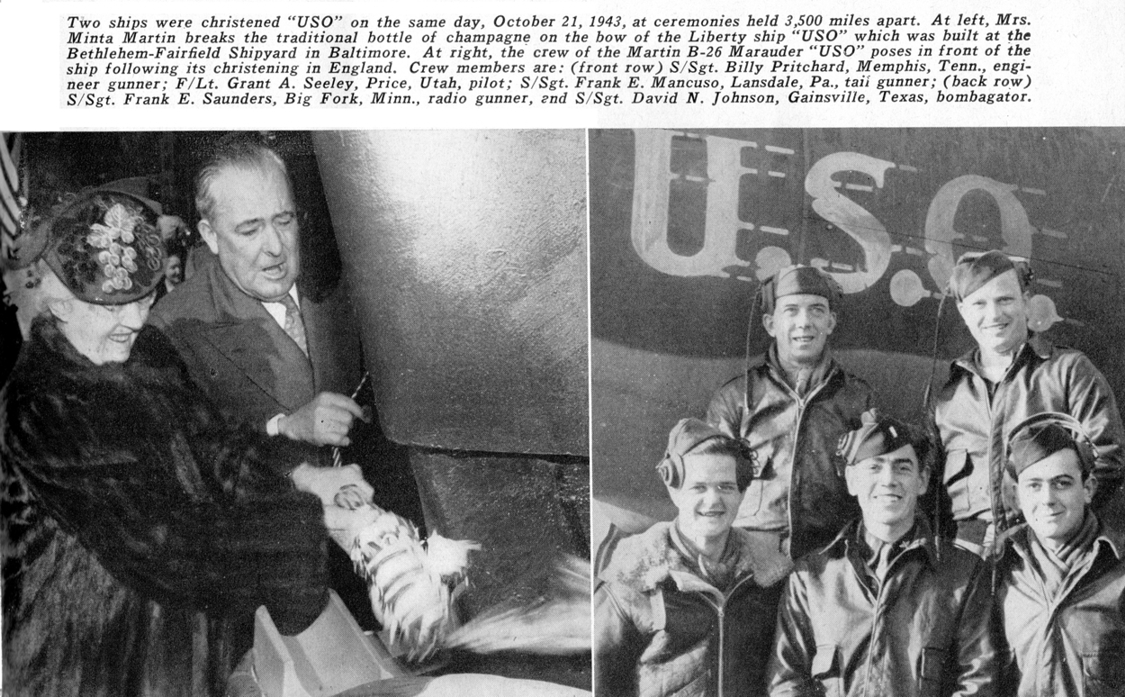
Billy passed away in 1972, having left the Air force only in 1964. His headstone in Cordova Community Cemetery in Shelby, Tennessee records his service in World war II and also the Korean War.
Compiled by Dennis Burke, 2023, Dublin and Sligo. With thanks
too the Seeley, Prichard and Wilson families. Also to Roy
Bozych, the 323rd BG historian and to A Flanagan and Brendan
McLeer
